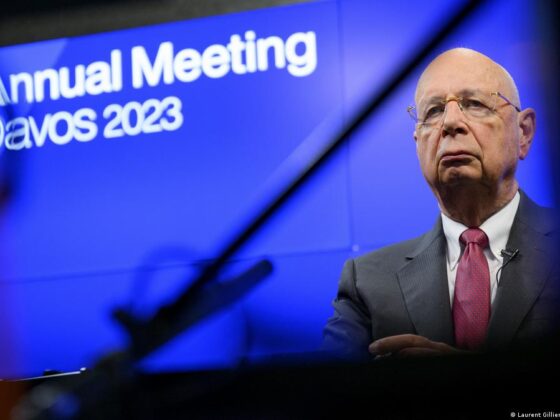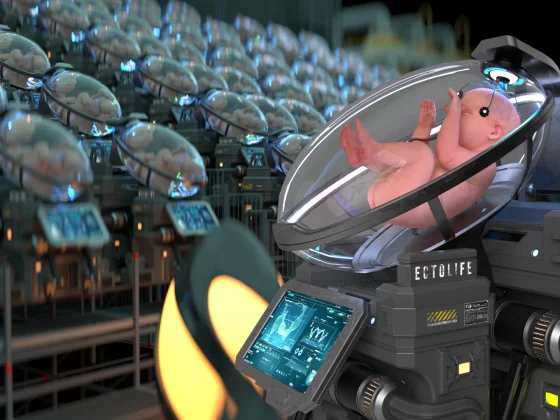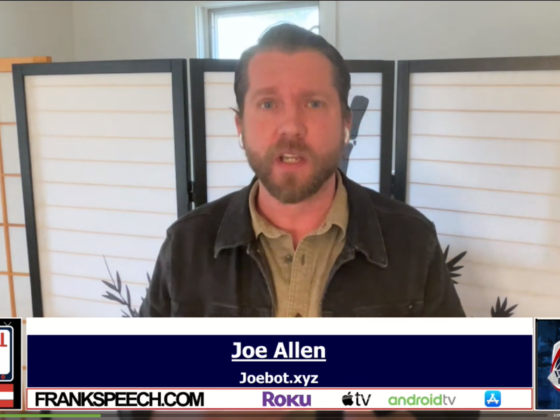By Iain Davis
Understanding Technocracy – Technocratic governance does not a Technate make
Over the last couple of years the question of technocratic governance has become a talking point in Western society. The debate concerns the degree to which qualified experts should influence or possibly even control policy.
Largely due to disillusionment with the political class, many people are broadly supportive of this idea. It is therefore crucial that we understand that technocratic governance is just one aspect of technocracy.
A Technate—technocracy applied to the whole of society—is not limited to technocratic governance. It goes much further and is a new and distinct sociopolitical construct.
A Technate vs Technocratic Governance
People have assumed that this is technocracy. It is not and it is vital that we understand the full, horrific implications of genuine technocracy.
If we look closer at this relationship between the expert—the technocrat—and the politician during the pseudopandemic, it is perhaps more accurate to say that the science was cherry picked by the politicians because it supported their policies. That being said, policy that is genuinely led by technocrats is not unusual in the West, especially monetary policy.
The political and economic response to Covid-19, on both sides of the Atlantic, exemplifies technocratic influence and control. For example, the economists and the financiers in the central banks—the “experts”—committed European Union (EU) taxpayers’ to fund policies without any meaningful oversight from the politicians.
Christine Lagarde, head of the European Central Bank (ECB), speaking in 2020, said:
The Governing Council is committed to doing everything necessary within its mandate to help the euro area through this crisis. [. . .] It is fully prepared to increase the size of its asset purchase program[.]
The Governing Council of the ECB decided that EU citizens needed to initially invest more than €1 trillion to effectively protect the liquidity of commercial banks. The ECB is completely independent from the European Parliament, the EU Commission and all EU member state governments:
Neither the ECB nor the national central banks (NCBs), nor any member of their decision-making bodies, are allowed to seek or take instructions from EU institutions or bodies, from any government of an EU Member State or from any other body.
The ECB Governing Council’s mandate is “to formulate monetary policy for the euro area.” Thus, to a significant extent, the EU’s economic policy is also shaped by unelected technocrats. It is said that taxation without representation is tyranny, but no one seems concerned. The EU Commission is keen to stress that the EU represents a “democracy that stands against autocracy.”
Regardless of the debate on the relative merits and weaknesses of technocratic governance, from global sustainable development and public health policy to economic and defence policy, technocrats are observably leading the formulation of policy around the world. But this alone is not technocracy.
In 1933 Technocracy inc. published its Technocracy Study Course which provided the technical specifications for a proposed North American continental technocracy. A society based upon the principles of technocracy is called a Technate:
Technocracy finds that the production and distribution of an abundance of physical wealth on a Continental scale for the use of all Continental citizens can only be accomplished by a Continental technological control, a governance of function, a Technate.
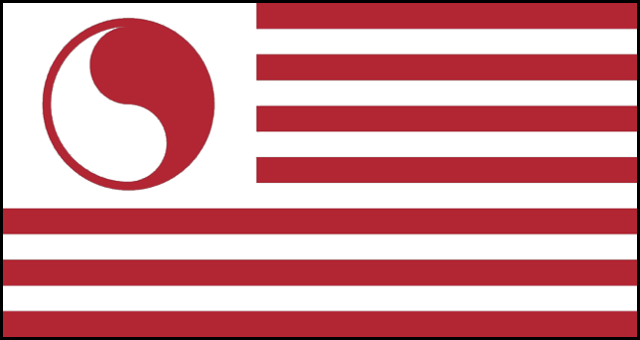
What Is Technocracy?
Technocracy is an apparently naive attempt by a small group of engineers, economists, sociologists and other boffins to address all social, economic and political problems, as they perceived them. This would allegedly be done by replacing the Western capitalist system and, in particular, the monetary system with technocracy. For the rest of the article we’ll call this group “the technocrats.”
Certain aspects of technocracy, such as its critique of “the Price System” (monetary system) and the legal system, were not without merit. The objective to provide “lives of abundance” to the people was commendable.
Unfortunately, like many seemingly well-intentioned ideas, technocracy’s many epistemic shortcomings, such as its complete failure to even acknowledge motivation, rendered it the perfect tool for authoritarians. In the hands of those who are motivated to exert global power, it is the most comprehensive system of social control ever devised. Hence its appeal to the parasite class.
In the technocracy model, “class,” in the socio-economic sense, is supposedly eliminated. This is another failing of the modellers: technocracy creates the most rigid class structure imaginable.
In their efforts to rid us of socio-economic class, the technocrats renamed the class structure “peck-rights.” They equated the immense complexity of human society to the “peck-rights” observed in cow herds and chicken coops. Consequently, they concluded that the best social organisation for humanity was one “where the individuals [are] placed as nearly as possible with respect to other individuals in accordance with peck-rights.”
Peck-rights, they argued, were earned by those with the requisite technical skills and natural ability to lead. Supposedly then, peck-rights are essential for human society to function as efficiently as possible. The technocracy Study Course states:
There must be as far as possible no inversion of the natural ‘peck-rights’ among the men.
The technocrats called their notion of peck-rights the “basis of spontaneous natural priority.” In their rather ham-fisted way, they were apparently trying to describe the “spontaneous order” suggested by the philosophers of the Scottish Enlightenment that were later formally proposed by economists like Friedrich Hayek and Milton Friedman.
In their seeming naiveté, the technocrats ignored the “elite theory” of Vilfredo Pareto, Gaetano Mosca, Roberto Michels and others, which demonstrated that political power is wielded by those who control resources. Like the technocrats, the elite theorists proffered that oligarchy was the result of some kind of meritocracy.
While both elite theory and technocracy considered this social order as inevitable, unlike technocracy, elite theory acknowledged how power could be corrupted and abused. The technocrats were seemingly unaware, or chose to ignore, the likelihood of this corruption continuing in their redesigned technocratic system.
In the Technocracy inc. Study Course the word “technocrat” isn’t referenced. Instead the “central headquarters” staffed by “technically trained personnel” administrate the “entire social operation, and all records of production and distribution” for the Technate. All social, industrial and technological “functions” were said to be interdependent and therefore the entire functional system could be centrally planned and managed.
The Technate would supposedly operate through careful control of the various “Functional Sequences”:
The basic unit of this organization is the Functional Sequence. A Functional Sequence is one of the larger industrial or social units, the various parts of which are related one to the other in a direct functional sequence. Thus among the major Industrial Sequences we have transportation (railroads, waterways, airways, highways and pipe lines); communication (mail, telephone, telegraph, radio and television); agriculture (farming, ranching, dairying, etc.); and the major industrial units such as textiles, iron and steel, etc. Among the Service Sequences are education (this would embrace the complete training of the younger generation), and public health (medicine, dentistry, public hygiene, and all hospitals and pharmaceutical plants as well as institutions for defectives).
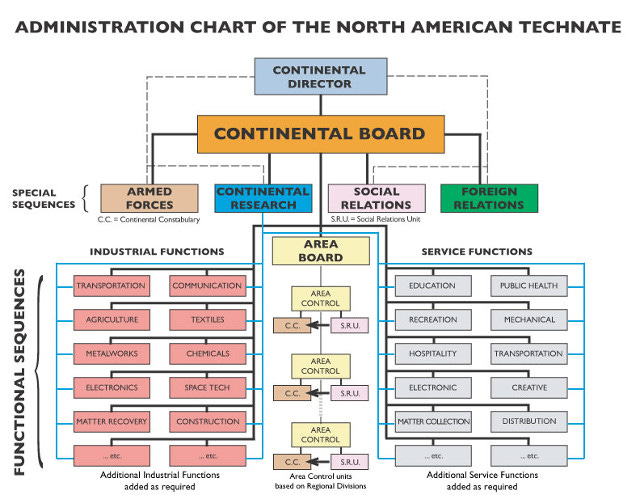
Additional “special” Functional Sequences were proposed. All technological and scientific development would be controlled through the Continental Research Sequence. The “Sequence of Social Relations” would oversee law and order. Juries were to be abolished and the Social Relations Sequence would create all the “rules” and its directors would subsequently investigate and pass judgement on all who did not function efficiently. As private property would also be abolished, there would be no litigation or disputes over property.
To their credit the technocrats did not consider the matter of legality to be definitive in determining the morality of a supposed “crime.” They even eschewed the word “crime.” Ironically, they pointed out that the legal system is interminably corrupt and that so-called justice could be bought. But they couldn’t comprehend of the nature of the corruption they had identified.
Technocracy falls flat on its face because the technocrats could not empathise with their fellow human beings. Consequently, they had no interdisciplinary appreciation of what Wilhelm Dilthey called “the human sciences.” They tried to redesign society while failing to appreciate what it is or how it forms.
This fundamental flaw in their approach was exemplified by their concept of “crime.” Whether illegal or not, they believed that all crime was entirely the product of “the Price System” and divorced from avarice or malevolence. The technocrats ignored motive and wrongdoing and ascribed all crime to means and opportunity alone.
The Sequence of Armed Forces would enforce the rules imposed by the Social Relations Sequence and act in accordance with the strategic decisions of the Foreign Affairs Sequence. The Armed Forces Sequence would not only coordinate the military defence of the Technate, but also internal security and the training and equipping of the Continental Constabulary.
All internal security would be controlled under “one single jurisdiction” with the Continental Constabulary enforcing the rules adjudicated by the Social Relations Sequence directorate.
The North American continent was to be split into regions managed by the “Area Control Sequence.” All of the Functional Sequences would be overseen by the Continental Control Sequence.
Thus, in technocracy, the entire Technate is ruled by one self-appointed body:
The personnel of all Functional Sequences will pyramid on the basis of ability to the head of each department within the Sequence, and the resultant general staff of each Sequence will be a part of the Continental Control. A government of function! The Continental Director, as the name implies, is the chief executive of the entire social mechanism. On his immediate staff are the Directors of the Armed Forces, the Foreign Relations, the Continental Research, and the Social Relations and Area Control. [. . .] The Continental Director is chosen from among the members of the Continental Control by the Continental Control. Due to the fact that this Control is composed of only some 100 or so members, all of whom know each other well, there is no one better fitted to make this choice than they.
Technocracy inc may have hoped to create a system that would provide all with “lives of abundance,” but the technocrats reduction of humans to biological machines effectively set technocracy as the zenith of inhuman totalitarianism. Despite its allusions to spontaneous order, technocracy overturns the economic and social mechanisms that could potentially allow spontaneous order to flourish. It replaces them with the ultimate system of centralised power and control of resources.
This is precisely the mechanism which enables power to oppress populations in the current sociopolitical system. As a Technate, on a continental and potentially global scale, that power can act without restraint.

The Science of Social Engineering
In 1938 in Technocrat Magazine vol. 3 No. 4 , the in-house magazine of Technocracy inc., technocracy was described as:
The science of social engineering, the scientific operation of the entire social mechanism to produce and distribute goods and services to the entire population.
As described above, a Technate manifests as a “government of function.” This means that the “production and distribution” of all goods, services and resources are centrally coordinated through a single system of “technological control.” As all citizens in the Technate are reliant upon decisions of Continental Control, this enables extensive social engineering through the “scientific operation” of society itself.
Having supposedly eradicated sociopolitical class—replacing it with peck-rights—society in a Technate is said to be divided into three “functional” classes. Children and youth are classed as those who have not yet begun their “social service at some function or other,” working adults perform their “service function” until they reach retirement, which the technocrats described as “the end of the period of service until the death of the individual.”
Consequently, the scientific operation of society enables the “service” of the “human animal” to act as the “human engine” for the efficient operation of the various Functional Sequences. Limits are set for the total expenditure of resources across the entire Technate, including human resources. In order for the Functional Sequences to remain “efficient” these must not be exceeded:
Achievement of these ends will result from a centralized control with a social organization built along functional lines, similar to that of the operating force of any large functional unit of the present such as the telephone system or the power system. [. . .] The population must be so trained and organized as to maintain the continuance of the operation within the limits specified.
The technocrats viewed the human “mind,” “conscience” and the “will” as redundant concepts founded in humanity’s “ignorant, barbarian past.” A human being was considered an object “which makes a certain variety of motions and noises,” likened to a dog or a vehicle. The purpose of the Technate was to socially engineer the behaviour of the “human animal” for its own good. The Study Course, speaking about humanity, noted:
They can be conditioned not to use certain language, not to eat certain foods on certain days, not to work on certain days, not to mate in the absence of certain ceremonial words spoken over them, not to break into a grocery store for food even though they may not have eaten for days.
The capitalist “Price System” was thought “inefficient” because “money” was the product of debt which therefore generated nothing but waste. By extinguishing the capitalist “Price System” Technocracy proposed that the cost of goods and services could be determined based upon the energy cost of production. A corresponding number of “energy certificates” would be created bi-annually, overseen by Continental Control, commensurate with the planned total energy expenditure of the Technate:
[E]nergy is measurable in units of work—ergs, joules, or foot-pounds. [. . .] There are a large number of different bookkeeping devices whereby the distribution to, and records of rate of consumption of the entire population can be kept. [. . .] By this system all books and records pertaining to consumption are kept by the Distribution Sequence of the social mechanism. The income is granted to the public in the form of energy certificates.
This would enable a comprehensive surveillance state that would monitor and control the transactions of every citizen in the Technate:
The record of one’s income and its rate of expenditure is kept by the Distribution Sequence, so that it is a simple matter at any time for the Distribution Sequence to ascertain the state of an unknown customer’s balance.
The technocrats idea was that all citizens would have an equal share of non-tradable energy certificates, allocated to them, with which to acquire goods and services. This would be more than sufficient for their needs and would thus eradicate poverty and ensure that all lived a life of abundance.
Allocated Energy Certificates would also record all of the personal data of the individual recipient citizen. Combined with the data gathering of the Distribution Sequence, this would allow the precise engineering of society by ensuring that the citizen used their Energy Certificates as specified to maintain the efficiency of the relevant Function Sequence:
The significance of this, from the point of view of knowledge of what is going on in the social system, and of social control, can best be appreciated when one surveys the whole system in perspective. First, one single organization is manning and operating the whole social mechanism. This same organization not only produces but distributes all goods and services. Hence a uniform system of record-keeping exists for the entire social operation, and all records of production and distribution clear to one central headquarters. Tabulation of the information [contained on the Energy Certificates] provides a complete record of distribution, or of the public rate of consumption by commodity, by sex, by regional division, by occupation, and by age group.
Regrettably, the technocrats’ understanding of oligarch power was peurile. In trying to create a fair system of wealth distribution they actually concocted a model that lends itself perfectly to a new form of rampant crony capitalism.
Technocracy Inc’s critique of “wealth,” outlined in 1933 in the publication Introduction To Technocracy, did not oppose wealth per se but redefined how it could be measured and distributed:
Under a Price System wealth arises solely through the creation of debt. [. . .] Physical wealth, on the other hand, is produced by converting available energy into use-forms and services. [. . .] Technology has introduced a new methodology in the creation of physical wealth.
The technocrats also decided that those with peck-rights “must” be given “ample leeway for the expression of individual initiative.” When these factors are combined with the proposed distribution of Energy Certificates the scope for a new model of crony capitalism is almost limitless:
[E]nergy can be allocated according to the uses to which it is to be put. The amount required for new plant, including roads, houses, hospitals, schools, etc., and for local transportation and communication will be deducted from the total as a sort of overhead, and not chargeable to individuals. After all of these deductions are made, [. . .] the remainder will be devoted to the production of goods and services to be consumed by the adult public-at-large. [. . .] Thus, if there be available the means of producing goods and services [. . .] each person would be granted an income[.]
The envisaged “fair” distribution of Energy Certificates to the population represented the “remainder.” Continental Control, and all the directors and the gifted individuals who have leeway to exercise their individual peck-rights, first decide how much they must allocate to themselves to maintain “the scientific operation of the entire social mechanism.” The people are allotted what is left “if” there is any “available.”

The Global Technocracy Approaches
The technological capability already exists to empower the new breed of technocrats to manage the population by controlling our access to resources. Advances in digital technology, described by the World Economic Forum as the 4th Industrial Revolution, have led to smart grids, the Internet of Things (IoT) and the required all-pervasive surveillance system.
Energy Certificates are now entirely feasible. The IoT, linked to the smart grid, will enable the constant, real time monitoring of energy usage and identification of when and where it is used and by whom. Arguments are currently being made that we must accept this level of control over our lives to meet our commitments to Sustainable Development.
The EU has already warned its population to prepare for energy rationing. There is every reason to suspect that this will soon apply to us on an individual basis. For example, via your personal carbon footprint tracker which could quite easily be linked to payments made with your issued Central Bank Digital Currency (CBDC), or some variation of it.
CBDC is “programmable money” which can be controlled by the issuer to restrict certain transactions. Potentially limiting how much you can spend on energy products, such as fuel or domestic power consumption.
The former Deputy Governor of the Bank of China and current Deputy Managing Director of the the International Monetary Fund (IMF), Bo li, told the IMF’s symposium on Central Bank Digital Currencies for Financial Inclusion: Risks and Rewards:
CBDC can allow government agencies and private sector players to program [CBDC] to create smart-contracts, to allow targetted policy functions. For example[,] welfare payments [. . .], consumptions coupons, [. . .] food stamps. By programming, CBDC money can be precisely targeted [to] what kind of [things] people can own, and what kind of use [for which] this money can be utilised.
This is precisely the “social control mechanism” technocracy advocates. As laid out in the Study Course:
Human beings, when fed, housed and clothed, in a manner which is not too uncomfortable, and when permitted normal social relationships among themselves, tend to crystallize their routine activities into non-varying social habits. [. . .] If, however [. . . ] these habits become incompatible with the same biological necessities of food, clothing, etc., the social habits are always observed to be readjusted [. . .] ‘Social change,’ Howard Scott has succinctly remarked, ‘tends to occur at a rate directly as the approach of the front of the stomach to the spine.’ [. . .] So long as the human beings are amply supplied with the basic biological necessities, food, necessary amounts of clothing and housing, and gregarious and sexual outlets, they will perform in a routine manner without upsetting either their conditioned responses or their conditioned inhibitions. They will literally face bullets in preference to social disapprobation.
Those who value technocratic governance imagine it technocracy consequently assume technocracy is nothing to be concerned about. They do not understand what technocracy is. A Technate is the most comprehensive form of tyranny ever devised by humanity.
This may not be what the technocrats intended but they were hobbled by their pride in their own claimed objectivity and wrongly assumed that Continental Control would be altruistic and equally objective. Their arrogance blinded them to the reality of human nature, which they neither understood nor accounted for.
A Technate degrades the citizen to the status of a dog or a machine. We only exist to serve Continental Control and the Function Sequences. These will be led by an untouchable parasite class who claim peck-rights and absolute authority over all.
Personally, I am opposed to the idea.





